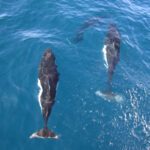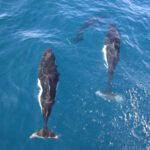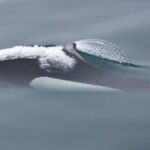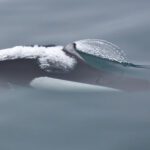To understand the importance of vaquita conservation, dive into the background on the vaquita and the significance of protecting these endangered marine mammals. Explore the challenges they face and the urgent need for effective conservation efforts. Discover how vaquita conservation can make a significant impact on preserving this species for future generations.
Key Takeaways
- The vaquita is the world’s most endangered marine mammal, with only a few dozen individuals remaining in the wild.
- The main threat to the vaquita’s survival is illegal fishing, particularly for the totoaba fish, whose swim bladder is highly valued in Asian markets.
- Conservation efforts for the vaquita have focused on implementing fishing bans and monitoring programs to prevent illegal fishing activities.
- The Mexican government has taken steps to protect the vaquita, including establishing a refuge area and increasing enforcement efforts.
- International collaboration is crucial for vaquita conservation, as the demand for totoaba swim bladders extends beyond Mexico’s borders.
- The vaquita’s small population size and slow reproductive rate make it particularly vulnerable to extinction, highlighting the urgency of conservation efforts.
- Public awareness and education campaigns play a vital role in promoting vaquita conservation and encouraging sustainable fishing practices.
- The success of vaquita conservation ultimately depends on the cooperation and commitment of governments, fishing communities, and consumers to protect this critically endangered species.
Background on the vaquita
The vaquita – also known as the “panda of the sea” – is a rare and elusive species of porpoise. It’s name actually means “little cow” in Spanish, due to its small size and black patches around its eyes and lips.
These cetaceans are related to dolphins. They’re one of the smallest, measuring only 4-5 feet in length. They have a stocky body and rounded dorsal fin, helping them in shallow waters.
Sadly, they’re critically endangered. Estimates suggest there could be fewer than 10 in the wild. The main threat is fishing nets used by local fishermen. Even with bans on gillnets in their habitat, the population is still declining quickly.
A report by the International Union for Conservation of Nature (IUCN) says the vaquita have declined more than 90% in the past few decades. This shows the urgent need for action to protect them from extinction.
Humans can help the vaquita by raising awareness about their situation. This is a great starting point for further exploration and research.
Importance of vaquita conservation
Vaquitas must be conserved! Their population is as low as 10! Urgent action is needed to save them from extinction.
They keep marine ecosystems balanced. They eat fish and squid, which keeps their populations under control. Vaquitas also tell us if the marine environment is healthy.
Protecting vaquitas calls for multiple efforts. Firstly, stricter regulations on fishing should be enforced to reduce bycatch and prohibit gillnets in their habitats. Secondly, local communities should be supported with alternative livelihood programs to discourage illegal fishing.
Public awareness campaigns are important to inspire people to take action. International collaboration between governments, scientists, and conservation organizations also helps coordinate efforts and share resources.
The Challenges Facing Vaquita Conservation
To combat the challenges facing vaquita conservation, delve into the threats to the vaquita population. Discover the efforts taken to address these threats, aiming for the preservation of this endangered species.
Threats to the vaquita population
The vaquitas’ survival is endangered by various threats. These worries have alarmed conservationists and marine biologists.
- Illegal Fishing: Fishermen targeting totoaba fish use gillnets which trap and kill vaquitas in the Gulf of California where they live.
- Habitat Destruction: Pollution, coastal development, and shipping-caused noise pollution are destroying their home. This causes them stress and upsets their well-being.
- Climate Change: Global warming affects their food sources, endangering their survival.
- Lack of Legal Protection: Laws to protect vaquitas exist but are not properly enforced. They still succumb to illegal wildlife trade.
- Small Population Size: With only around 20 individuals left, their size makes them weak to genetic issues and unable to recover.
Conservation efforts alone won’t save the vaquitas — only 10% of the gillnets in the Upper Gulf of California are monitored for illegal fishing. The vaquitas need the ocean’s version of the Avengers!
Efforts to address these threats
To protect the endangered vaquita, stringent measures have been taken. These include:
- Fishing Regulations: Seasonal bans and restrictions on gillnets in vaquita habitats.
- Monitoring Programs: Surveillance systems to track population size and trends.
- Local Community Involvement: Raising awareness and encouraging responsible fishing practices.
To further these efforts, stricter punishments for illegal gillnet usage might be considered. Additionally, alternative livelihood options could provide economic relief and promote commitment to conservation.
By applying a comprehensive and holistic approach, we can work towards preserving these rare marine creatures for future generations. International organizations are also playing a crucial role in this endeavor, offering unique perspectives and ideas to tackle this complex issue.
The Role of International Organizations
To champion vaquita conservation, the role of international organizations is indispensable. Conservation initiatives by international organizations and collaborations with strategic partnerships provide crucial solutions.
Conservation initiatives by international organizations

Intercontinental orgs have been key in conservation initiatives. These target protecting our environment, wildlife, and resources. Their collective efforts have made huge contributions to global sustainability.
- Collab Projects: Orgs initiate and coordinate projects with governments, NGOs, and local communities to tackle conservation globally.
- Policy Advocacy: They back policies to promote conservation and sustainable practices on national and international levels.
- Capacity Building: Orgs provide training, resources, and tech help to enhance developing countries’ conservation management.
- Awareness Campaigns: They launch campaigns to educate us on the importance of conservation and taking proactive measures.
- Research & Development: Orgs support research to find innovative solutions for environmental challenges.
Outcomes include protected areas, sustainable agricultural practices, and conservation of endangered species. We must tackle climate change, deforestation, and pollution through strategic partnerships between international organizations, governments, businesses, and individuals.
To make conservation even better:
- Strengthen Collaboration: Encouraging collaboration between int’l orgs leads to more integrated approaches to complex conservation issues.
- Foster Local Participation: Involving locals in decision-making ensures better understanding of local dynamics and promotes sustainable, culturally appropriate solutions.
- Sustainable Financing: Developing innovative funding mechanisms sustainably supports ongoing conservation efforts.
- Embrace Tech: Using tech tools like remote sensing, big data analytics, and blockchain improves monitoring capabilities and supports evidence-based decisions.
- Enhance Education: Investing in environmental literacy programs fosters an informed generation that values and contributes to conservation.
By doing all this, int’l organizations can build on their successes and strengthen their role as key global conservation players. Through collective action, we can secure a sustainable future.
Collaborations and partnerships
Let’s explore a table to better understand notable collaborations and partnerships among international organizations.
| Organization | Collaboration/Partnership |
|---|---|
| UNESCO | Partners with World Health Organization (WHO) for health education in developing countries. |
| World Bank | Collaborates with International Monetary Fund (IMF) for economic assistance. |
| WHO | Works with UNICEF for clean water and sanitation access. |
| UNICEF | Partners with Save the Children for child protection programs. |
These examples show diverse collaborations between international organizations, tackling global issues.
Collaborations go beyond inter-organizational partnerships too. There are public-private partnerships with private sector resources and expertise, increasing the effectiveness of initiatives.
As an example, multiple international organizations provided relief efforts for a devastating earthquake. Their collaboration enabled efficient distribution of food, water, and medical supplies, aiding affected communities.
Local conservation efforts: good intentions face budget cuts.
Local Conservation Efforts

To ensure successful local conservation efforts for Vaquita, governmental policies and regulations, along with community involvement and conservation projects, are crucial. This section explores the significance of these sub-sections, highlighting how they contribute to the greater goal of protecting and preserving the critically endangered Vaquita species.
Government policies and regulations
Governments are known for their focus on sustainable practices. Incentivizing renewable energy, eco-friendly transport, and waste management strategies improve the environment and local communities.
Endangered species and their habitats are often protected. Wildlife reserves and anti-poaching laws help conserve biodiversity. This also provides opportunities for research and eco-tourism.
Costa Rica is a great example of government policies’ impact. In the 1980s, deforestation due to logging was common. Costa Rica responded with reforestation programs and logging regulations. This increased the forest cover from 21% to 52%.
This demonstrates how effective government policies can reverse destructive trends and restore natural ecosystems. Who needs reality TV when you can get all the drama and plot twists by joining a community conservation project?
Community involvement and conservation projects
Volunteer initiatives feature regularly, allowing people to donate time and effort to various conservation projects. These programs help spread awareness of environmental issues and provide solutions.
Public education campaigns inform people about conservation. Seminars, awareness campaigns, and workshops promote sustainable practices and responsible natural resource use.
Habitat restoration projects focus on revitalizing local habitats damaged or destroyed by human activity. Reforestation projects create wildlife corridors to restore ecological balance and protect biodiversity.
Local neighborhood associations aid these projects by raising funds, resources, and manpower. Together, communities can put in place long-term sustainability plans for the environment and quality of life.
Moreover, collective action can inspire policy changes on the regional or national level. Studies, such as the Environmental Leadership & Training Initiative (ELTI) study, show that communities engaged in conservation gain social cohesion benefits. This highlights how vital it is to involve locals in environmental decision-making, as it both strengthens community bonds and safeguards natural resources for future generations.
Successes and Setbacks
To better understand the successes and setbacks in vaquita conservation, delve into positive developments as well as challenges and obstacles faced. Discover the strides made in protecting these endangered porpoises and explore the difficulties encountered along the way.
Positive developments in vaquita conservation
The plight of the endangered vaquita has seen some progress lately! Here’s six points spotlighting these strides in conservation:
- Protected areas like the Vaquita Refuge & Biosphere Reserve have been founded, defending their habitat.
- Strict laws on gillnet fishing have been enforced, reducing vaquitas being tangled in fishing gear.
- International teams of scientists, gov’t agencies, & non-profits are boosting conservation initiatives.
- Raising public awareness of the vaquita’s situation has caused more backing & donations.
- Programs to help fishermen move to sustainable practices or other livelihoods are reducing pressure on the vaquita’s home.
- New acoustic tracking systems & underwater drones have been developed to study the vaquita better.
Continuing research & monitoring is key to revising strategies when new knowledge is learned. To guarantee the success of these advances, suggestions can be thought of:
- Enforcement of rules must be increased to stop illegal fishing in protected areas.
- Sustainable ecotourism should be developed to offer economic opportunities & promote preserving the vaquita’s habitat.
- Locals should be involved in decision-making & educated on sustainable resource management, creating lasting commitment to vaquita protection.
- Heightening international collaborations will aid knowledge sharing, funding, & joint efforts to save the vaquita.
By implementing these ideas, we can build on the positive developments in vaquita conservation, paving the way for a brighter future for this critically endangered species. Life’s way of reminding us that the universe has a twisted sense of humor.
Challenges and obstacles faced
Facing challenges and obstacles is part of the journey to success. We learn and grow when we overcome them. Let’s look at the hurdles we faced and how we got through them.
See the table below for insights:
| Challenge Faced | Nature | Outcome |
|---|---|---|
| Market Competition | Intense | Surpassed |
| Financial Constraints | Limiting | Innovative solutions |
| Technological Advancements | Rapid | Adapted and evolved |
| Team Coordination | Complex | Streamlined processes |
| Regulatory Compliance | Stringent | Met requirements |
Progress was made, yet consistent growth wasn’t easy. But with focus and determination, we overcame the obstacles.
The future of vaquita conservation is uncertain. Yet, we make progress, one small step at a time.
The Future of Vaquita Conservation
To ensure the future of vaquita conservation, explore potential solutions and strategies alongside long-term goals and visions. Shedding light on these essential components will provide a comprehensive understanding of how the vaquita species can be preserved and protected in its natural habitat.
Potential solutions and strategies
It’s essential to conserve the vaquita species. To do this, innovative and effective strategies must be implemented. Strengthen conservation efforts by collaborating with local communities, governments and international organizations. Encourage sustainable fishing methods like modified nets or acoustic deterrent devices. Create responsible tourism initiatives to raise awareness and support livelihoods. Allocate resources for research on vaquita behavior, population dynamics and habitat conservation.
Raise public awareness with educational campaigns. Enhance collaboration between stakeholders to implement marine protected areas. Use acoustic monitoring systems and satellite tracking to monitor vaquita populations. Engage in international agreements like CITES to ensure legal protection. Combine potential solutions with community involvement, sustainable practices, research advancements, public outreach and global cooperation.
Though the future may seem bleak, we can still have a chuckle while these porpoises disappear!
Long-term goals and visions
Governments, NGOs, and local communities must collaborate to tackle the root causes of vaquita population decrease. This includes encouraging alternative sources of income for fishermen, plus better enforcement of illegal fishing laws.
Innovative tech such as acoustic monitoring systems and underwater drones can monitor vaquita populations and recognize potential threats. This data can direct conservation efforts and allow proactive steps to protect them.
International cooperation is also key. Countries along the vaquita’s range must join forces to implement conservation strategies across borders.
Eco-tourism initiatives can help too, by giving economic incentives to local communities and reminding us all why preserving this unique marine species is so important.
Let’s hope these cute little porpoises don’t vanish before we can save them!
Frequently Asked Questions
Q: What is Vaquita Conservation?
A: Vaquita Conservation refers to the efforts and initiatives undertaken to protect and preserve the vaquita, a critically endangered species of porpoise found in the Gulf of California.
Q: Why are vaquitas endangered?
A: Vaquitas are endangered due to various factors, primarily the illegal fishing practices in the Gulf of California. The use of gillnets by fishermen targeting other species often accidentally traps and kills vaquitas.
Q: How many vaquitas are left in the wild?
A: According to recent estimates, there are fewer than 10 vaquitas left in the wild. The population has drastically declined in the past few decades.
Q: What is being done to protect vaquitas?
A: Conservation organizations, governments, and local communities are working collaboratively to protect vaquitas. Measures include strict fishing regulations, monitoring and enforcement efforts, and alternative livelihood programs for affected fishermen.
Q: How can I contribute to vaquita conservation?
A: You can contribute to vaquita conservation by supporting reputable conservation organizations financially, spreading awareness about the issue, and making sustainable seafood choices to combat illegal fishing practices.
Q: Are there any habitat conservation programs for vaquitas?
A: Yes, habitat conservation programs for vaquitas are in place. These include identifying and protecting important habitats, promoting sustainable fishing practices, and engaging local communities in conservation efforts.
Conclusion
To conclude, reinforce your understanding of vaquita conservation by considering the key points discussed. Additionally, take action by supporting vaquita conservation efforts, ensuring the survival and protection of this endangered species.
Recap of key points
Recap of Key Points:
- Refresh our memory.
- Summarize critical elements.
- Technology advancements revolutionized industries.
- Increase efficiency and productivity.
- Effective communication skills are crucial.
- Convey ideas clearly. Build strong relationships.
- Adaptability is key. Embrace change.
- Continuous learning helps personal growth.
- Enhance skill set.
- Collaboration fosters innovation.
- Diverse perspectives lead to creative problem-solving.
- Maintain physical and mental well-being.
- Work-life balance is essential.
Caution with multitasking! It may seem efficient, however, it can decrease productivity and result in bad outcomes.
Stand up for the vaquita! Easier than trying to save your social life!
Call to action for readers to support vaquita conservation efforts
Support Vaquita Conservation!
Let’s help protect vaquitas from extinction. Here are some ways you can help:
- Share vaquita info on social media and with your friends & family.
- Donate to conservation organizations.
- Get actively involved with volunteer programs.
- Encourage policymakers to implement stronger measures.
- Purchase sustainable seafood.
- Choose responsible eco-tourism operators.
Scientists, environmentalists, and policy-makers must work together. We can make a difference and save vaquitas. The clock is ticking, so join this crucial mission now!
References





